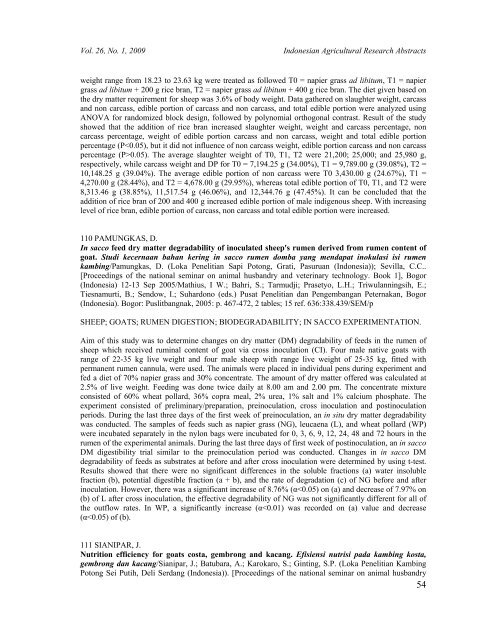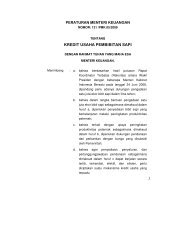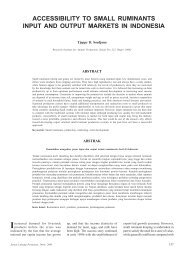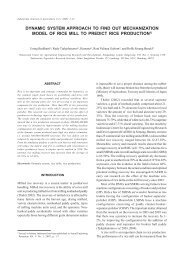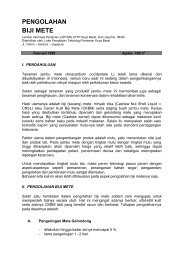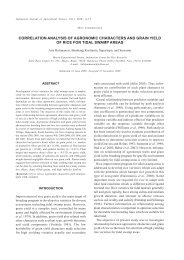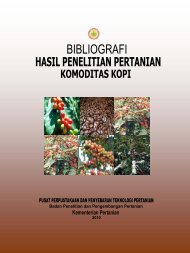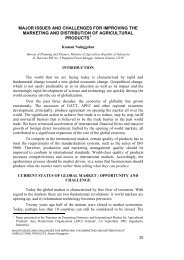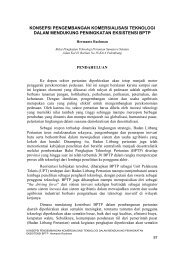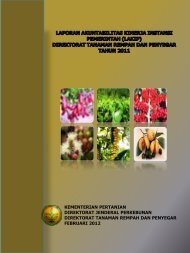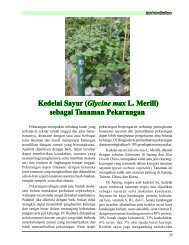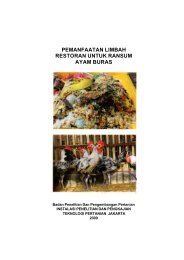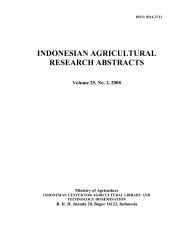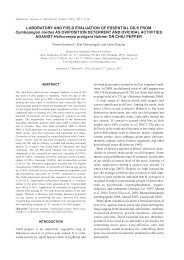Indonesian Agricultural Research Abstracts <strong>Vol</strong>. 26, <strong>No</strong>. 1, <strong>2009</strong>1,200 to 1,875 gs. Cirebon ducks were more homogeneous than the tegal, and the feather color wasgenerally slightly darker than the tegal. The body weight was similar to the tegal, varied from 1,325 to1,865 gs with the average of 1,555 gs. Turi ducks had characteristic slender posture and erect gait withmajority light brown with black bill and feet. The average body weight varied from 1,270 to 1,795 gs. Thisresult could be used to improve database, supporting the standardization and development of local duckincluding to support genetic resources conservation program.L51 ANIMAL PHYSIOLOGY - NUTRITION108 HASAN, Z.H.Potency of Lactobacillus isolated from chickens digestive tracts as probiotics agents: its toleranceand resistance towards bile salt. Potensi isolat Lactobacillus dari saluran pencernaan ayam sebagaiagensia probiotik: toleransi dan ketahanannya terhadap garam empedu/Hasan, Z.H. (Balai PengkajianTeknologl Pertanian Kalimantan Selatan, Banjarbaru (Indonesia)). [Proceedings of the national seminar onanimal husbandry and veterinary technology], Bogor (Indonesia) 12-13 Sep 2005/Mathius, I W.; Bahri, S.;Tarmudji; Prasetyo, L.H.; Triwulanningsih, E.; Tiesnamurti, B.; Sendow, I.; Suhardono (eds.) PusatPenelitian dan Pengembangan Peternakan, Bogor (Indonesia). Bogor: Puslitbangnak, 2005: p. 721-726, 3ill., 3 tables; 15 ref. 636:338.439/SEM/pCHICKENS; ISOLATION; LACTOBACILLUS; PROBIOTICS; DIGESTION; BILE SALTS.The objective of this research was to find out the potency of Lactobacillus isolated from chickensdigestive tracts as probiotic agents. The research was conducted by inoculating the isolates ofLactobacillus in GYP (glucose-yeast extract-peptone) liquid media, added with bile salt in variousconcentrations, 0.2; 0.4; 0.6; 0.8; 1.0% (w/v), and the media without bile salt as the control. The isolates inthis liquid media was inoculated in GYP agar media using pour plate method. Incubation was carried outat 37 0 C for 24 hours. The test to know its tolerance towards bile salt was done by observing its growth,that was measuring by the OD (optical density) of the media after incubation. The production of lactic acidwas known by measuring the pH of the growth media after incubation, and the volume of 0.1 N NaOHneeded for titration the media. The resistance of the isolates towards bile salt was done by counting theamount of the colony which was inoculated on GYP agar, before and after incubation, using total platecount (TPC) method. Nine isolates of Lactobacillus isolated from chicken digestive tracts were tested.These 9 isolates consisted of 4 isolates from caecum were identified as Lactobacillus murinus, while 5isolates from crop were identified as 1 isolate of Lactobacillus acidophilus and 4 isolates of Lactobacillusmurinus. All isolates could grow in the media containing bile salt up to the concentration of 1.0%, but theresult for the test of its resistance towards bile salt showed that the amount of the viable cell was decliningafter incubation for 24 hours. The decline of viable cell for isolate 6, 8, 9 was 1 log cycle, isolate 7 was 2log cycle, while isolate 1-5 did not decline.109 LESTARI, C.M.S.Edible portion of male indigenous sheep fed rice bran and napier grass. Edible portion domba lokaljantan yang diberi pakan dedak padi dan rumput gajah/Lestari, C.M.S.; Dartosukarno, S.; Puspita, I.(Universitas Diponegoro, Semarang (Indonesia). Fakultas Peternakan). [Proceedings of the nationalseminar on animal husbandry and veterinary technology. Book 1], Bogor (Indonesia) 12-13 Sep2005/Mathius, I W.; Bahri, S.; Tarmudji; Prasetyo, L.H.; Triwulanningsih, E.; Tiesnamurti, B.; Sendow,I.; Suhardono (eds.) Pusat Penelitian dan Pengembangan Peternakan, Bogor (Indonesia). Bogor:Puslitbangnak, 2005: p. 461-466, 2 tables; 15 ref. 636:338.439/SEM/pSHEEP; MALES; FEEDS; RICE; BRAN; PENNISETUM PURPUREUM; CARCASSES.The experiment was conducted to evaluate the influence of rice bran levels with napier grass as a basaldiet on edible portion of male indigenous sheep. Twelve yearling male indigenous sheep with initial body53
<strong>Vol</strong>. 26, <strong>No</strong>. 1, <strong>2009</strong>Indonesian Agricultural Research Abstractsweight range from 18.23 to 23.63 kg were treated as followed T0 = napier grass ad libitum, T1 = napiergrass ad libitum + 200 g rice bran, T2 = napier grass ad libitum + 400 g rice bran. The diet given based onthe dry matter requirement for sheep was 3.6% of body weight. Data gathered on slaughter weight, carcassand non carcass, edible portion of carcass and non carcass, and total edible portion were analyzed usingANOVA for randomized block design, followed by polynomial orthogonal contrast. Result of the studyshowed that the addition of rice bran increased slaughter weight, weight and carcass percentage, noncarcass percentage, weight of edible portion carcass and non carcass, weight and total edible portionpercentage (P0.05). The average slaughter weight of T0, T1, T2 were 21,200; 25,000; and 25,980 g,respectively, while carcass weight and DP for T0 = 7,194.25 g (34.00%), T1 = 9,789.00 g (39.08%), T2 =10,148.25 g (39.04%). The average edible portion of non carcass were T0 3,430.00 g (24.67%), T1 =4,270.00 g (28.44%), and T2 = 4,678.00 g (29.95%), whereas total edible portion of T0, T1, and T2 were8,313.46 g (38.85%), 11,517.54 g (46.06%), and 12,344.76 g (47.45%). It can be concluded that theaddition of rice bran of 200 and 400 g increased edible portion of male indigenous sheep. With increasinglevel of rice bran, edible portion of carcass, non carcass and total edible portion were increased.110 PAMUNGKAS, D.In sacco feed dry matter degradability of inoculated sheep's rumen derived from rumen content ofgoat. Studi kecernaan bahan kering in sacco rumen domba yang mendapat inokulasi isi rumenkambing/Pamungkas, D. (Loka Penelitian Sapi Potong, Grati, Pasuruan (Indonesia)); Sevilla, C.C..[Proceedings of the national seminar on animal husbandry and veterinary technology. Book 1], Bogor(Indonesia) 12-13 Sep 2005/Mathius, I W.; Bahri, S.; Tarmudji; Prasetyo, L.H.; Triwulanningsih, E.;Tiesnamurti, B.; Sendow, I.; Suhardono (eds.) Pusat Penelitian dan Pengembangan Peternakan, Bogor(Indonesia). Bogor: Puslitbangnak, 2005: p. 467-472, 2 tables; 15 ref. 636:338.439/SEM/pSHEEP; GOATS; RUMEN DIGESTION; BIODEGRADABILITY; IN SACCO EXPERIMENTATION.Aim of this study was to determine changes on dry matter (DM) degradability of feeds in the rumen ofsheep which received ruminal content of goat via cross inoculation (CI). Four male native goats withrange of 22-35 kg live weight and four male sheep with range live weight of 25-35 kg, fitted withpermanent rumen cannula, were used. The animals were placed in individual pens during experiment andfed a diet of 70% napier grass and 30% concentrate. The amount of dry matter offered was calculated at2.5% of live weight. Feeding was done twice daily at 8.00 am and 2.00 pm. The concentrate mixtureconsisted of 60% wheat pollard, 36% copra meal, 2% urea, 1% salt and 1% calcium phosphate. Theexperiment consisted of preliminary/preparation, preinoculation, cross inoculation and postinoculationperiods. During the last three days of the first week of preinoculation, an in situ dry matter degradabilitywas conducted. The samples of feeds such as napier grass (NG), leucaena (L), and wheat pollard (WP)were incubated separately in the nylon bags were incubated for 0, 3, 6, 9, 12, 24, 48 and 72 hours in therumen of the experimental animals. During the last three days of first week of postinoculation, an in saccoDM digestibility trial similar to the preinoculation period was conducted. Changes in in sacco DMdegradability of feeds as substrates at before and after cross inoculation were determined by using t-test.Results showed that there were no significant differences in the soluble fractions (a) water insolublefraction (b), potential digestible fraction (a + b), and the rate of degradation (c) of NG before and afterinoculation. However, there was a significant increase of 8.76% (α
- Page 5:
Vol. 26, No. 1, 2009Indonesian Agri
- Page 8 and 9: Indonesian Agricultural Research Ab
- Page 10 and 11: Indonesian Agricultural Research Ab
- Page 13 and 14: Vol. 26, No. 1, 2009Indonesian Agri
- Page 15 and 16: Vol. 26, No. 1, 2009Indonesian Agri
- Page 17 and 18: Vol. 26, No. 1, 2009Indonesian Agri
- Page 19 and 20: Vol. 26, No. 1, 2009Indonesian Agri
- Page 21 and 22: Vol. 26, No. 1, 2009Indonesian Agri
- Page 23 and 24: Vol. 26, No. 1, 2009Indonesian Agri
- Page 25 and 26: Vol. 26, No. 1, 2009Indonesian Agri
- Page 27 and 28: Vol. 26, No. 1, 2009Indonesian Agri
- Page 29 and 30: Vol. 26, No. 1, 2009Indonesian Agri
- Page 31 and 32: Vol. 26, No. 1, 2009Indonesian Agri
- Page 33 and 34: Vol. 26, No. 1, 2009Indonesian Agri
- Page 35 and 36: Vol. 26, No. 1, 2009Indonesian Agri
- Page 37 and 38: Vol. 26, No. 1, 2009Indonesian Agri
- Page 39 and 40: Vol. 26, No. 1, 2009Indonesian Agri
- Page 41 and 42: Vol. 26, No. 1, 2009Indonesian Agri
- Page 43 and 44: Vol. 26, No. 1, 2009Indonesian Agri
- Page 45 and 46: Vol. 26, No. 1, 2009Indonesian Agri
- Page 47 and 48: Vol. 26, No. 1, 2009Indonesian Agri
- Page 49 and 50: Vol. 26, No. 1, 2009Indonesian Agri
- Page 51 and 52: Vol. 26, No. 1, 2009Indonesian Agri
- Page 53 and 54: Vol. 26, No. 1, 2009Indonesian Agri
- Page 55 and 56: Vol. 26, No. 1, 2009Indonesian Agri
- Page 57: Vol. 26, No. 1, 2009Indonesian Agri
- Page 61 and 62: Vol. 26, No. 1, 2009Indonesian Agri
- Page 63 and 64: Vol. 26, No. 1, 2009Indonesian Agri
- Page 65 and 66: Vol. 26, No. 1, 2009Indonesian Agri
- Page 67 and 68: Vol. 26, No. 1, 2009Indonesian Agri
- Page 69 and 70: Vol. 26, No. 1, 2009Indonesian Agri
- Page 71 and 72: Vol. 26, No. 1, 2009Indonesian Agri
- Page 73 and 74: Vol. 26, No. 1, 2009Indonesian Agri
- Page 75 and 76: Vol. 26, No. 1, 2009Indonesian Agri
- Page 77 and 78: Vol. 26, No. 1, 2009Indonesian Agri
- Page 79 and 80: Vol. 26, No. 1, 2009Indonesian Agri
- Page 81 and 82: Vol. 26, No. 1, 2009Dickinson, M.J.
- Page 83 and 84: Vol. 26, No. 1, 2009Indonesian Agri
- Page 85 and 86: Vol. 26, No. 1, 2009Indonesian Agri
- Page 87 and 88: Indonesian Agricultural Research Ab
- Page 89 and 90: Indonesian Agricultural Research Ab
- Page 91 and 92: Indonesian Agricultural Research Ab
- Page 93 and 94: Indonesian Agricultural Research Ab
- Page 95 and 96: Indonesian Agricultural Research Ab
- Page 97 and 98: Indonesian Agricultural Research Ab
- Page 99: Indonesian Agricultural Research Ab


